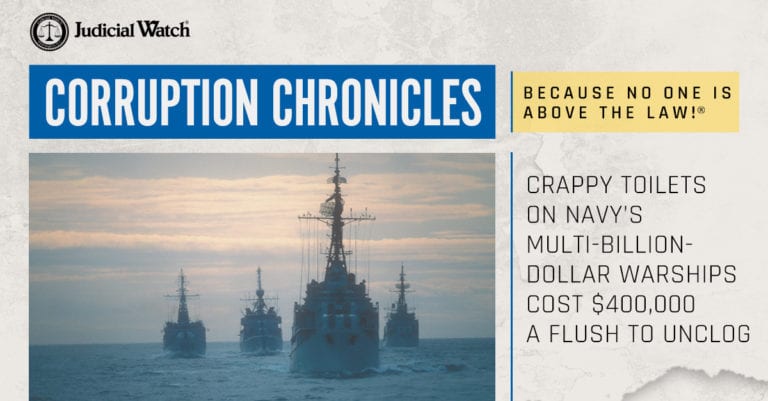
Crappy Toilets on Navy’s Multi-Billion-Dollar Warships Cost $400,000 a Flush to Unclog

Even during a global pandemic there is government waste to report. Here is a great example. The toilet system on two new, state-of-the-art Navy aircraft carriers is so crappy that it must be cleansed with specialized acids that cost American taxpayers a breathtaking $400,000 a flush. It may seem like a bad joke but, sadly, it is par for the course for many government agencies. The outrageous toilet expense is a snippet of a larger problem involving the Navy’s multi-billion-dollar budget to maintain its fleet. A new federal audit offers a break down by ship class and, while there are other highly questionable losses, the defective toilets appear to be in a class of their own.
First some background provided by congressional investigators from the nonpartisan Government Accountability Office (GAO), which conducted the probe. Each of the last three years the U.S. Navy requested $40 billion to build, operate and maintain a fleet of some of the most technologically advanced ships in the world. “Though these resources are significant, the Navy has nevertheless struggled to build and maintain ships to its desired standards within estimated cost and schedule,” according to the GAO, which found that in the last decade aircraft carriers, destroyers and submarines require more effort to sustain than initially planned. “In assessing how these classes of ships are sustained, GAO found 150 examples of class-wide problems, such as unreliable ship systems,” the report states. “These problems stemmed from shipbuilding programs not identifying, evaluating, or mitigating sustainment risks during the acquisition process.”
This indicates that, like a multitude of other government enterprises, the Navy made bad investments that have ended up squandering huge amounts of public funds. In fact, congressional investigators found that it would cost an eye-popping $4.2 billion to correct just 30% of the problems for which the Navy had data on estimated repair costs. That is because the Navy violates Department of Defense (DOD) guidelines by failing to consider the full cost of sustaining vessels during the acquisition process. “As a result, for six shipbuilding programs whose costs GAO could assess, the Navy had underestimated sustainment costs by $130 billion,” according to the report, which provides a chart of the six ships with a breakdown of the operating and support figures. The real numbers will never be fully exposed because the DOD is not required to provide detailed information about shipbuilding programs’ sustainment cost growth to Congress, the probe reveals.
The report is tiresome, spanning more than 100 pages with graphs and charts that may seem overwhelming to many. It also delves into the boring DOD acquisition process and other tedious information that may deter many from finding key nuggets like the toilet scandal, which is buried deep in the document. The Navy’s two newest aircraft carriers—a CVN 78 known as the USS Gerald R. Ford and a CVN 77 known as the USS George H. W. Bush—use a deficient toilet and sewage system that clogs regularly. The system is similar to what commercial planes use but supposedly increased in scale to accommodate a crew of more than 4,000. “To address unexpected and frequent clogging of the system, the Navy has determined that it needs to acid flush the CVN 77 and 78’s sewage system on a regular basis, which is an unplanned maintenance action for the entire service life of the ship,” the GAO writes. “According to fleet maintenance officials, while each acid flush costs about $400,000, the Navy has yet to determine how often and for how many ships this action will need to be repeated, making the full cost impact difficult to quantify.” Both vessels cost American taxpayers tens of billions of dollars.
“The Carrier toilet system is indicative of the kinds of issues we highlight in our report that are requiring more money, time, and effort to fix than originally anticipated due to a lack of adequate sustainment planning during the acquisition process,” according to a GAO director, Shelby Oakley, in charge of ship acquisition probes. “The pipes are too narrow and when there are a bunch of sailors flushing the toilet at the same time, like in the morning, the suction doesn’t work. The Navy didn’t anticipate this problem.” Neither did American taxpayers and, to be fair, this is the kind of waste we see across a broad spectrum of government agencies.
















